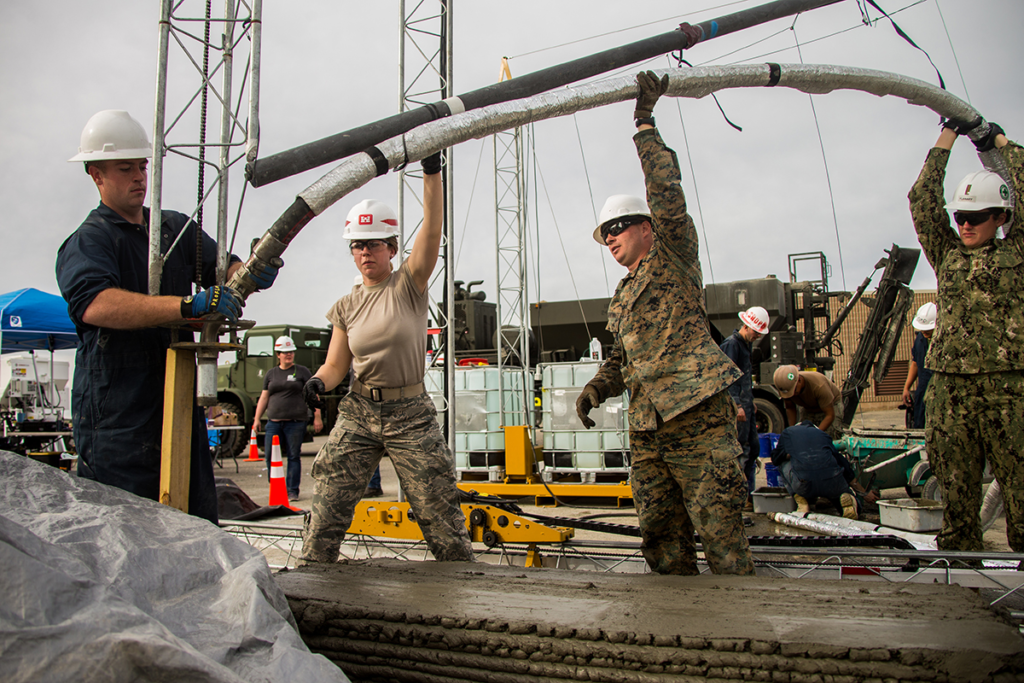The U.S. military is entering a new age of construction by testing and using advanced techniques such as 3D printing and Cross-Laminated Timber (CLT). These new technologies are not just improving construction speed—they’re helping the military create more eco-friendly, cost-effective, and rapidly deployable buildings for bases and field operations.
The Department of Defense (DoD) is investing in both tools to meet modern military needs, such as fast shelter setup in remote locations, reduced dependency on traditional materials, and better energy use. These innovations are part of a long-term plan to improve both the performance and sustainability of military infrastructure.
Visit the Department of Defense website to follow updates on these technologies.
3D Printing: Faster, Smarter Construction

3D printing, also known as additive manufacturing, allows military engineers to build structures by adding material layer by layer from a digital design. This method greatly reduces labor needs and speeds up the process.
One of the most well-known demonstrations was by the U.S. Marines, who built a 500-square-foot barracks using a 3D concrete printer in just 40 hours. Projects like this show how effective 3D printing can be in fast-moving missions or disaster zones.
Additive manufacturing also lets teams produce complex structures directly on-site, which reduces transportation costs and time.
Learn how the Army is adopting 3D printing
CLT: Timber With Strength and Sustainability
Cross-Laminated Timber (CLT) is made by layering boards of wood in alternating directions and bonding them together. This results in strong panels that can replace concrete and steel in many buildings.
For the U.S. military, CLT is especially attractive because it’s:
- Lightweight and easy to transport
- Energy-efficient
- Made from renewable resources
- Able to be built off-site and assembled quickly
- Fire-resistant and strong during earthquakes
CLT has been used in Europe for many years and is now gaining approval in the U.S., not just for civilian use, but in defense projects as well.
Explore the benefits of CLT at WoodWorks
Why the Military Is Making the Switch
Here are the main reasons the military is focusing on 3D printing and CLT:
- Speed: Structures can be built in days, not weeks.
- Efficiency: Digital designs reduce material waste.
- Cost-saving: Fewer workers, faster builds, and lower transportation costs.
- Environmental Benefits: Less CO2 emissions and better insulation.
- Adaptability: Easy to design for specific climates or missions.
These benefits are particularly helpful for Forward Operating Bases (FOBs) and temporary medical camps, where speed and mobility are critical.
The U.S. Army Engineer Research and Development Center is now experimenting with combining both CLT and 3D printing for hybrid building methods.
Real-Life Projects and Testing
Pilot projects are happening across the country. In the Mojave Desert, the U.S. Air Force is testing 3D-printed living quarters that can handle harsh weather while using minimal water. At Joint Base Lewis-McChord, CLT buildings are being monitored for long-term durability and comfort.

These projects help test whether the technologies can work not just in theory but under real-world military conditions. Early feedback is promising.
Obstacles and Solutions
While the technologies are promising, there are still a few roadblocks:
- Equipment size: Moving and setting up 3D printers in rough terrain is difficult.
- Training: Personnel must be trained to use new systems.
- Building codes: Some states still restrict CLT construction.
- Material supply: Keeping enough high-quality material on hand can be a challenge.
To tackle these, the DoD is working closely with universities like MIT and startups like ICON and Mighty Buildings. These partnerships are helping to solve technical problems and update policy.
Sustainability and Climate Goals
The Pentagon has also linked these construction methods with its climate strategy. By using wood instead of concrete and local materials in 3D printing, the military can cut its carbon footprint while saving money and resources.
In fact, the U.S. military has committed to net-zero emissions by 2050. Technologies like CLT and additive manufacturing are expected to play a key role in reaching that goal.
Learn more about the DoD’s climate goals
Civilian Use Could Follow
The military’s success with these technologies could shape the civilian construction industry, especially in areas like:
- Emergency housing
- Disaster relief shelters
- Rural healthcare centers
- Temporary schools
Using the military as a testing ground, the government and private sector could adapt these methods for broader use.
Final Thoughts
The U.S. military’s exploration of 3D printing and CLT represents a major step in modernizing defense construction. These technologies are not just about new tools—they are part of a strategy to build smarter, faster, and greener.
As these pilot programs expand, we may soon see 3D-printed barracks and CLT command centers becoming the norm across U.S. bases—and potentially influencing how civilian buildings are designed in the future.
Also Read – Mead Law Group Unveils New Mediation Arm in Nevada






